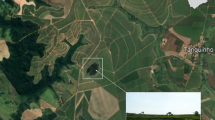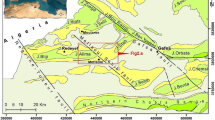Abstract
The subsurface runoff in the permafrost zone shows considerable structural and seasonal specifics. The structural features are due, on the one hand, to the lithologically determined permeable zones of rock massifs and, on the other hand, the permeability governed by lithology. This permeability is a seasonal factor of water flow from the territory, and now it is the focus of studies in various aspects. The structural character is determined by the history of its geological and geocryological development: the runoff structures are most often inherited by the position of rocks of coarser lithological composition or features associated with former geocryological processes (fracturing, formation of cryogenic textures, local thermokarst, etc.). The spatial heterogeneity of the above-permafrost runoff was studied in the European North and in the mountains of the Northern Transbaikalia.







Similar content being viewed by others
REFERENCES
Duchkov, A.D. and Sokolova, L.S., Geothermal Atlas of Siberia, in Zakonomernosti stroeniya i evolyutsii geosfer: Mater. Mezhdunar. mezhdistsiplinar. nauch. simpoz. (Regularities in the Structure and Evolution of Geospheres: Proc. Intern. Interdiscipl. Sci. Symp.), Khabarovsk, 2004, pp. 45–56.
Zheleznyak, M.N., Geotemperature field and cryolithozone in Southeastern Siberian Platform, Doct. Sci. (Geol.–Meneral.) Dissertation, Yakutsk: Inst. Merzlotovedeniya, Siberian Branch, Russian Academy of Sciences, 2002, p. 337.
Zheleznyak, M.N., Geotemperaturnoe pole i kriolitozona Yugo-Vostoka Sibirskoi platformy (Geotemperature Field and Cryolithozone in Southeastern Siberian Platform), Novosibirsk: Nauka, 2005.
Redozubov, D.V., Geotermicheskii metod issledovaniya tolshch merzlykh porod (Geothermal Method for Studying Permafrost Rock Strata), Moscow: Nauka, 1966.
Rivkin, F.M., Vlasova, Yu.V., and Parmuzin, I.S., Regularities in changes in geocryological conditions caused by settling permafrost rocks at their thawing, Kriosf. Zemli, 2017, vol. 21, no. 6, pp. 26–34.
Romanovskii, N.N., Podzemnye vody kriolitozony (Groundwater in Permafrost Zone), Vsevolozh-skii, V.A., Ed., Moscow: Mosk. Gos. Univ., 1983.
Sergeev, D.O., Romanovskii, N.N., Gavrilov, A.V., Buldovich, S.N., Tipenko, G.S., Ioshikava, K., and Romanovskii, V., Effect of the dynamics of climate and geocryological conditions on the regime of regional runoff and naled-formation in mountain drainage basins of the Lena River, Kriosf. Zemli, 2009, vol. 13, no. 3, pp. 29–35.
Shastkevich, Yu.G., Permafrost rocks in the high-mountain part of the Udokan Ridge and formation conditions of their temperature regime, in Geokriologicheskie usloviya Zabaikal’skogo Severa (Geocryological Conditions in Northern Transbaikalia), Novosibirsk: Nauka, 1966, pp. 24–43.
Akhtar, M., Ahmad, N., and Booij, M.J., Use of regional climate model simulations as input for hydrological models for the Hindukush-Karakorum-Himalaya region, Hydrol. Earth System Sci., 2009, no. 7, pp. 1075–1089.
Connon, R.F. and Quinton, W.L., Changing runoff pathways due to permafrost thaw in discontinuous permafrost terrains, XI Int. Conf. Permafrost—Book of Abstracts, Günther, F. and Morgenstern, A., Eds., Potsdam: Germany: Bibliothek Wissenschaftspark Albert Einstein, 2016.
Letts, M.G., Roulet, N.T., Comer, N.T., Skarupa, M.R., and Verseghy, D.L., Parametrization of peatland hydraulic properties for the Canadian land surface scheme, Atmos.-Ocean, 2000, no. 1, pp. 141–160.
Lewkowicz, A.G. and French, H.M., The hydrology of small runoff plots in an area of continuous permafrost, Banks Island, N.W.T., Proc. 4th Canadian Permafrost. Conf., 1982, pp. 151–162.
Liljedahl, A.K., Boike, J., Daanen, R.P., et al., Pan-Arctic ice-wedge degradation in warming permafrost and its influence on tundra hydrology, Nature Geosci., 2016, vol. 9, pp. 312–318.
Pomeroy, J.W., Gray, D.M., Brown, T., Hedstrom, N.R., Quinton, W.L., Granger, R.J., and Carey, S.K., The cold regions hydrological model: a platform for basing process representation and model structure on physical evidence, Hydrol. Processes, 2007, vol. 21, pp. 2650–2666.
Ryden, B.E., Hydrology of Truelove Lowland, in Truelove Lowland, Devon Island, Canada: A High Arctic Ecosystem, Bliss, L.C., Ed., Edmonton, AB: Univ. of Alberta Press, 1977, pp. 107–136
Funding
This study was carried out under governmental orders (research subjects, governmental registration AAAA-A19-119021190077-6 and AAAA-A19-119040990079-3).
Author information
Authors and Affiliations
Corresponding author
Additional information
Translated by G. Krichevets
Rights and permissions
About this article
Cite this article
Chesnokova, I.V., Bezdelova, A.P., Sergeev, D.O. et al. The Signs and the Role of Structures of Subsurface Flow in Permafrost Zone. Water Resour 48, 804–812 (2021). https://doi.org/10.1134/S0097807821050067
Received:
Revised:
Accepted:
Published:
Issue Date:
DOI: https://doi.org/10.1134/S0097807821050067




